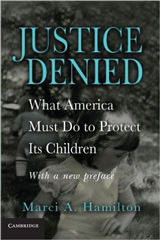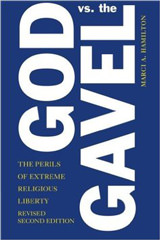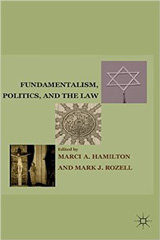Have you ever wondered how six conservative Catholic Supreme Court Justices were able to be on the Supreme Court at the same time? There is an additional liberal Catholic, Justice Sotomayor, but all conservatives on the Court now were raised Catholic. Doesn’t it strike you as odd that all of the conservatives are Catholic, and that no evangelical is among them, given the abortion litmus test among Republicans? Compare the current Court’s conservative makeup with the face of today’s anti-abortion movement, which is mostly evangelical in the headlines, though the Catholic Church hierarchy has always lobbied to make abortion illegal. Period. No exceptions for rape, incest, or any other reason. Six Catholics overturned Roe v. Wade in Dobbs v. Jackson Women’s Health Organization. Of course, Supreme Court appointments are mired in politics, but in a country with extraordinary religious diversity, this configuration demands explanation.
The 1981 Court: 3 Episcopalians, 2 Presbyterians, and one Catholic, Lutheran, Methodist, and Protestant
When Justice Sandra Day O’Connor, who is Episcopalian, joined the Court in 1981, there were two other Episcopalians (Justices Thurgood Marshall and Byron White), two Presbyterians (Chief Justice Warren Burger and Justice Lewis Powell, Jr.), a Catholic (Justice William Brennan), a Lutheran (Justice William Rehnquist), a Methodist (Justice Harry Blackmun), and a Protestant (Justice John Paul Stevens). Obviously, this was a Christian lineup, lacking in full diversity, but the six faiths on the Court meant that six different faith perspectives informed the people making the most important legal issues in the country. Before you jump to the conclusion that the Protestant sects count as one, understand that is not true with respect to their positions on public policy. Each is distinctive. Justice Brennan promised to obey the Constitution in his Court rulings, not his religious faith, which guided his personal life but not the country’s.
Following O’Connor’s appointment by President Ronald Reagan in 1981, eight of the nine appointees by Republican Presidents until today have been conservative Roman Catholics. Taken in historical order, they were Justices Antonin Scalia, Anthony Kennedy, Clarence Thomas, Chief Justice John Roberts, Samuel Alito, Neil Gorsuch, Brett Kavanaugh, and Amy Coney Barrett. The only other Republican appointee since 1981 was Justice David Souter, who is an Episcopalian.
The current Court has six Catholics in the majority: Chief Justice Roberts and Justices Thomas, Alito, Gorsuch, Kavanaugh, and Barrett, plus a liberal Catholic (Justice Sotomayor), a Jew (Justice Kagan), and a Protestant (Justice Ketanji Brown). Few people have questioned why the Supreme Court does not reflect the religious diversity of the population of the United States. We all should wonder why it happened without much opposition from this diverse United States.
The 1970s and 1980s Are the Seedbed for the Current Supreme Court’s Conservative Makeup
In 1971, the Supreme Court affirmed a lower court decision in Coit v. Green, which held that a private school with racially discriminatory policies was ineligible for federal tax-exempt status; the ruling set aside whether it might be permissible if religiously motivated. Following Coit, the IRS enforced the rule, though schools that even merely announced a non-discrimination policy were eligible for tax-exempt status. Eleven years later, the Court decided a case in which the reason for the racial discrimination was religious in Bob Jones University v. United States, wherein the university barred interracial dating due to their religious beliefs. The school expelled any student engaged in interracial dating. The Justices applied the Coit principle, holding that even if the racial discrimination was based on religious belief, the school could not obtain tax-exempt status. The discriminators’ fight was motivated by opposition to President Jimmy Carter’s administration, which emphasized that the government must remove tax-exempt status from Bob Jones University, which openly discriminated on the basis of race.
This conclusion did not sit well with evangelical Rev. Jerry Falwell, who formed the Moral Majority in 1979 in part to establish that religious freedom should overcome anti-discrimination laws. He created the organization with the encouragement and assistance of Paul Weyrich, a Melkite Greek Catholic and powerful conservative political strategist, who had established the Heritage Foundation in 1973.
Throughout his career, Weyrich forcefully shaped the right-wing agenda that opposed abortion and same-sex marriage, and embraced the concept that Judeo-Christian beliefs are necessary for successful Western democracies. As Randall Balmer explained in his must-read article on the rise of the religious right, evangelicals were not really opposed to abortion until Weyrich persuaded them to join the battle against abortion as a means of pushing a conservative agenda. Toward the end of the 1970s, fundamentalist Presbyterian preacher and theologian Francis Schaeffer constructed the theology to mobilize evangelicals against abortion. His son, Frank Schaeffer, who was brought into his father’s anti-abortion movement at a young age—and now regrets his involvement—provides an excellent summary of the evolution of evangelical beliefs about abortion. Once a “Catholic issue,” anti-abortion stances expanded to evangelicals.
Francis Schaeffer also introduced the phrase “secular humanism” to label those opposed to the emerging evangelical religious beliefs. Some of the Christian Right argued that evangelical President Jimmy Carter was a secular humanist who wrongly supported the Court’s abortion decisions, and since his presidency have worked to oppose anyone like him. Imagine thinking Jimmy Carter is not a good enough Christian! That was the moment in history when the abortion movement pushed itself onto a pedestal and sought to de-legitimize their opponents. They were the religious activists who were supposedly being opposed by the godless; their faith made them superior to the supporters of abortion. Abortion became the “most religious” political fight in the United States.
That framing is fading, at least on the left. Once Roe was overturned, the many faiths that believe in choice quickly entered the public square to declare that their religious faith was being suppressed by the draconian anti-abortion laws. Lawsuits against extreme abortion laws brought by believers and clergy in Florida, Indiana, and Wyoming are finally challenging the Schaeffer worldview.
During the 1980s, the Moral Majority backed a number of Catholic candidates. Yet, according to Crisis Magazine, as of 1982, evangelicals were not in sync with each other on any social issue except for abortion. That same year, the right-wing Federalist Society was established.
Leonard Leo: Conservative Catholic Justice-Maker
The Federalist Society became a major architect of conservative politics, outlasting the Moral Majority, which folded during the late 1980s. Leonard Leo, a conservative Catholic, founded the Cornell Law School chapter in 1989, and upon graduation, went to work for the Federalist Society in Washington in 1991 until 2020, though he continued to serve on the Board.
Leo has been a dedicated servant to the Catholic faith through many positions, including being on the boards of the Catholic Association, the Catholic Association Foundation, and the National Catholic Prayer Breakfast. President George W. Bush’s campaign appointed him as their Catholic strategist.
He frequently took leaves of absence from the Federalist Society to lead Justice campaigns, from Thomas to Barrett, becoming the Court’s conservative Catholic Justice-maker. He is responsible for the Catholics on the Court since 1991. In 2016, he played a pivotal role in creating candidate Donald Trump’s list of 20 jurists and attorneys as potential nominees to the Supreme Court, which was updated in 2017 with 5 more including Kavanaugh and Barrett. As the New Yorker in 2017 informed us, he was the man behind Gorsuch and the Supreme Court pipeline. What the article does not delve into is why his picks always result in a Catholic Justice. There was a nominee who was an evangelical, Harriet Miers, nominated on his watch, but Leo undermined her nomination by saying she didn’t have Federalist Society credentials and then maneuvered Alito into the spot instead.
The Roman Catholic Church Has Its Own Reasons to Populate the Court, Other Than Abortion
Parallel to the 1980s conservative political movement, in 1985, Catholic priest and Secretary-Canonist to the Vatican embassy, Thomas Doyle, attorney Ray Mouton, and Rev. Michael Petersen, M.D., wrote and sent a searing report to the United States Catholic bishops laying out the breadth and depth of clergy sex abuse in the church and warning the bishops that they faced potential ruination for the cover-up and its attendant civil lawsuits and criminal prosecutions. Some lawsuits had already generated verdicts in the millions of dollars, and the report drilled down on the criminal, civil, and canon law repercussions.
The bishops declined to address the issue publicly as the authors urged, but they were on clear notice that they faced hundreds if not thousands of lawsuits by victims. The report was reinforced by their own knowledge of the content of the Secret Archives in each diocese, which store information regarding abusive priests. Thus, the bishops were fully aware at that point that they were likely to face lawsuits and prosecution that could put them in a bad light.
For those unfamiliar with the tactics by the bishops against their victims, it may sound harsh to say that they would do everything they can to pack the courts in the face of the impending lawsuits. Yet, American bishops and their operatives aggressively fight in the legislatures and the courts for their self-interest every day. That makes them no different from any other large organization, but Americans cling to the 1950s conception of churches in the polity. The bishops may not have taken the authors’ sage advice or followed their better angels, but they did adopt a scorched earth legal strategy against their victims.
First, they have made every effort to suppress new information about abusers or victims from getting to the public. Their most fervent wish is about public relations. They want to make this all go away, which the vibrant victims’ movements around the globe will not permit.
Second, they have paid hundreds of millions of dollars to lobby in every state against victims’ access to justice through statute of limitations reform. They shamelessly lobby with misleading statements that there will be many false claims and that they will “go bankrupt,” while gaslighting lawmakers by saying that they have the best child protection policies now. That’s patently untrue as shown in this study by the nonprofit think tank, CHILD USA.
Third, they have paid hundreds of millions of dollars to local and big law defense attorneys to battle their victims in court, using hardball tactics and inevitably re-traumatizing them. Imagine arguing, for example, that child sexual abuse is the child’s fault because he seduces the priest. Yes, they have argued that. Fourth, they have filed over 30 federal bankruptcy claims under Chapter 11, which has cost them hundreds of millions in attorney’s fees, and is toxic to child sex abuse victims, as explained here. They throw around the phrase “going bankrupt” as though the diocese will be indigent and incapable of moving forward when, in fact, they file for voluntary bankruptcy to reorganize and protect their assets from the victims.
The bishops’ “Catholic Conferences” lobby in every state and the Capital. They don’t wait for the law to affect them; they plan and invest. Weyrich was persuading Catholics and evangelicals to come together to achieve their religious ends through politics in the 1980s while Doyle, Mouton, and Petersen were informing the bishops of their impending crisis. It would be rank naivete to think Catholic operatives haven’t also pushed for Catholic Justices to protect them from the scandal they created.
If there were any doubt that a conservative Catholic judge might put Church before duties, note the recent example of Trump-appointed federal Judge Greg Guidry in New Orleans, who has been charged with handling appeals in the federal bankruptcy brought by the New Orleans Archdiocese against the victims. He donated nearly $50,000 to the Archdiocese before and after his involvement and has consistently ruled in favor of the Archdiocese. He resolutely refused to recuse himself until the public learned that his contributions were made in conjunction with one of the Archdiocese’s defense attorneys. He finally removed himself when it became clear he was violating federal law that prohibited him from creating even an appearance of conflict. Imagine the same issue arising at the Supreme Court where there is no enforceable federal law that limits their recusal decisions, as Justice Thomas has recently illustrated when he refused to recuse himself in cases related to his wife’s political advocacy. In this century, when the motive is religious, the end routinely justifies the means. If the issue were only abortion, one would expect Leo and others to push for a mix of evangelical and Catholic court appointees. When only Catholic nominees have been appointed 8 out of 9 times by Republican Presidents since 1986, the specter of this earth-shaking scandal must be acknowledged.
The pattern of conservative Catholic Supreme Court appointments is so stark it cannot be explained away by political accident. It is intentional, and the United States must now guard against the unfortunate result: a loss of trust in the institution because of overt religious leanings. True harm has been done to our highest Court. As discussed here, there is reason to be concerned about Presidents, lawmakers, and Justices using their positions of power to advance propositions of faith rather than the public policies needed by all Americans. Evangelicals are in the spotlight now on abortion, but arch-Catholic operatives are making extraordinary progress toward making their beliefs the law of the land.
How are theocracies formed and fought? Politics.









